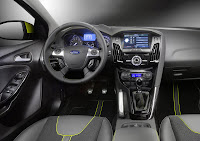Buick Regal GS, 2011
Buick revealed the production version of the 2012 Buick Regal GS, an even sportier expression of the Regal sport sedan that went on sale in 2010 and has attracted new buyers to the Buick family. Powered by a high-output, exclusive Ecotec 2.0L turbocharged engine mated to a six-speed manual transmission, the GS delivers an estimated 255 horsepower (190 kW) and 295 lb.-ft. of torque for a 0-60 mph performance of less than seven seconds (estimated). Buick's Interactive Drive Control System is standard on the GS, allowing drivers to customize the driving experience by changing the suspension settings and steering sensitivity between three modes: standard, sport and GS.
The highlights:
- Exclusive Ecotec 2.0L turbocharged and intercooled engine rated at an estimated 255 horsepower (190 kW) and 295 lb-ft of torque (400 Nm)
- Six-speed manual transmission, with six-speed automatic with Driver Shift Control to be offered later
- Interactive Drive Control System with GS mode
- Four-wheel independent system with HiPerStrut front suspension
- High-performance four-wheel disc brake system with Brembo front calipers
- Standard 19-inch, 5-Twin Spoke alloy wheels and all-season tire and optional 20-inch, 5-Twin Spoke polished alloy wheels with performance tires.
Inside is a racing-inspired, flat-bottom sport steering wheel and metal sport pedals, along with leather-appointed 12-way power-adjustable sport driver and front passenger heated seats, which include four-way power lumbar. The GS-specific black interior is accented with satin-finish elements on the instrument panel, steering wheel and console, while the instrument panel glows white when the driver engages the GS mode of the Interactive Drive Control System (IDCS).
Standard amenities for the Buick Regal GS:
- Passive keyless entry with push-button start
- Standard XM Satellite Radio with three-month trial service
- Harmon/Kardon premium 320-watt sound system with nine speakers
- Bluetooth phone connectivity
- Leather-wrapped flat-bottom steering wheel with audio controls
- Leather-appointed sport seating
- Heated driver and front passenger seats, with 12-way adjustable driver and front passenger seats - including four-way lumbar adjustment
- 120-volt accessory power outlet
- Power windows with express up/down feature in the front and express down in the rear
- Front and rear ultrasonic parking assist
- Bi-xenon HID headlamps
Power for the Regal GS comes from a high-output version of the Ecotec 2.0L turbocharged DOHC VVT engine with direct injection technology. It is based on the engine that will be available on Regal CXL later this year, but the engine and turbocharger are tuned to deliver greater boost pressure in the GS. The output is rated at 255 horsepower (190 kW) and 295 lb.-ft. of torque (400 Nm). A three-inch-diameter exhaust system provides reduced back pressure, resulting in higher engine power
Direct injection technology helps the engine deliver more power through increased efficiency, while maintaining fuel economy and lowering emissions. That means less fuel is consumed and lower emissions generated - including a 25-percent drop in cold-start hydrocarbon emissions. Variable valve timing optimizes power, efficiency and emissions across the entire rpm band.
The engine is mated to a standard six-speed manual transmission. A six-speed automatic transmission will be available later.
The Buick Regal GS rides on a relatively long wheelbase of 107.8 inches (2738 mm), which delivers refined, well-balanced vehicle dynamics. It also features a four-wheel-independent suspension, with a unique High Performance Strut (HiPerStrut) front suspension design. The HiPerStrut system helps reduce torque steer and maintain negative camber during cornering; the driver experiences reduced torque steer, improved grip and increased cornering power, along with crisper handling, steering precision and feedback.
The four-link independent rear suspension is designed to minimize unwanted toe and camber effects during spirited driving maneuvers, enhancing vehicle stability. Both front and rear dampers incorporate active Computer Damping Control (CDC), continuously changing damper characteristics to maintain optimal vehicle ride control over varying road surfaces and profiles. More aggressive, performance-oriented damping characteristics can also be selected by the driver through the Interactive Driver Control System.
Braking power comes from a large diameter four-wheel disc brake system featuring Brembo front calipers. A standard, four-channel anti-lock brake system is tuned to reduce stopping distances over varied road surfaces and conditions. An electronic parking brake is actuated via a center console-mounted control. The Buick Regal GS also features standard StabiliTrak stability control system with integrated, full-function traction control.
Interactive Drive Control System
The Buick Regal GS is also equipped with Interactive Drive Control System (IDCS) chassis technology (also offered on other Regal models with the 2.0L turbo engine). It delivers enhanced vehicle stability and greater driving safety. The driver selects among three operating modes - standard, sport and GS - that change the suspension settings, and steering sensitivity through the variable-effort steering system.
A sophisticated driving mode control module continually monitors driving style utilizing yaw rate, lateral and longitudinal acceleration, steering wheel, throttle and vehicle speed. It defines the dynamic vehicle state, including acceleration, braking and cornering, to optimize chassis reactions. It also executes all of the IDCS driver selections. All four dampers are electronically controlled and continuously adapt within milliseconds to the prevailing road conditions, vehicle movements and individual driving style.
Selecting GS mode optimizes the car for dynamic driving, tightening the suspension and steering response. "Standard," or the default mode, is the setting for all-around use. The sport mode provides a level of performance between standard and the GS modes.






















































